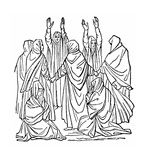
The Gospels of Peter & Mary
THE FIGURES BEHIND THE EVANGELISTS
One of the most powerful arguments for the reliability of the Gospels is the fact that two of them were written by eyewitnesses: Matthew and John. There is another fact, however, that is equally important. The other two evangelists, Mark and Luke, were not eyewitnesses to the life of Jesus, but they were in extremely close touch with those who were. Mark was Peter’s secretary, and Luke, who spent a good deal of time in Ephesus where Mary lived, is said to have painted her portrait. What is interesting is just how heavily Mark’s Gospel appears to have been influenced by Peter, and Luke’s by Our Lady.
Eusebius, the first great Christian historian, calls Mark an “interpreter of Peter” who “transmitted to us in writing” the things the first Pope preached, and this is borne out by the text. From Mark’s Gospel comes the most detailed account of the cure of Peter’s mother-in-law, along with the most complete coverage of Peter’s denial of Christ. Still another incident involving Peter covered most completely by Mark is the time Peter walked on water. After recording that Jesus Himself had walked on water that day, Mark adds that Our Lord would have passed His Apostles by had they not called out to Him in fright, thinking they were seeing a ghost (cf. Mk. 6:48-49).
Given that Peter answered almost all of Christ’s questions and gave voice to nearly all of the Apostles’ queries, one is not surprised to find that Mark is the go-to Gospel for information on Jesus’ teaching style. One learns that Our Lord matched His parables to the intellectual level of His listeners and explained everything to the Apostles in private, also that His critics stopped questioning Him after He bested them in debate, and that there were times when even His own disciples fell silent (cf. 4:33-34; 9:32; 12:34).
The man to whom Jesus entrusted “the keys to the kingdom of heaven” and who heads every list of Apostles would have been politically astute and, therefore, adept at sensing moods. If Our Lord sighed at times, if He looked indignant or angry, one would expect to hear about it from Mark, and one does (cf. 3:5; 7:34; 8:12; 10:14).
You May Also Enjoy
Biblical scholars may follow the first two steps of scientific procedure (formulation of hypothesis and accumulation of evidence) but cannot proceed to the third (verification).
If our Lord could use "narrow gate" imagery to spur His listeners to repentance, then so can we.
A wise and ancient scholar named Waniphallis (d. 666) once remarked to his Latin colleagues…

